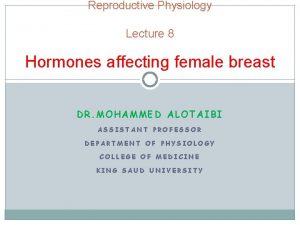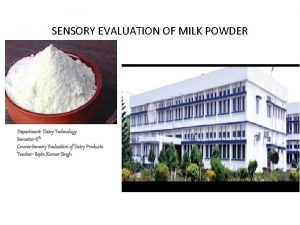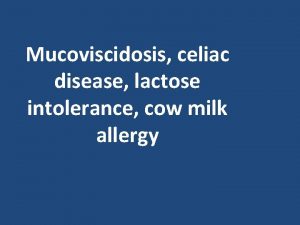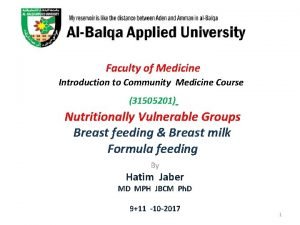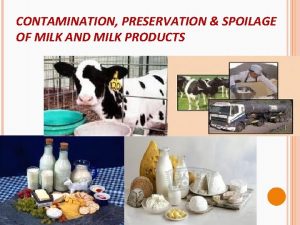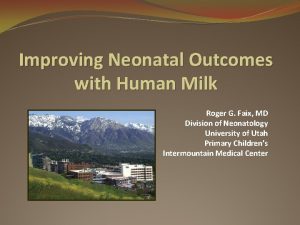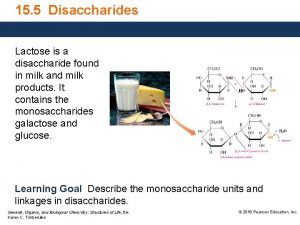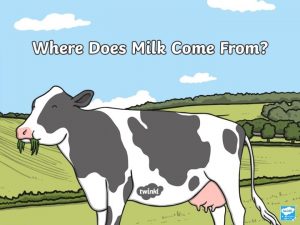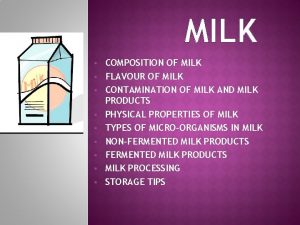Milk Milk Where does milk come from Milk














- Slides: 14

Milk

Milk Where does milk come from? • Milk is produced by all female mammals to feed their young, such as cows, goats, buffalo, camels and sheep. • It is produced once the female has given birth to the young mammal. • Milk is classed as a ‘complete’ food because it contains all essential nutrients needed by newborn mammals. • All mammals stop drinking milk once they are old enough to eat solid food. Humans are the exception. We continue to include milk in our diets. 2

Milk Why is milk so good for us? • Milk contains high biological value proteins which are needed for growth and the repair and maintenance of all body cells. • Whole milk contains about 3. 8% fat. • Milk has natural sugar (carbohydrate) in the form of lactose. • Milk is a good source of vitamin A (there is also a trace of vitamin D). • Milk has lower levels of the vitamin B group. • Milk is a good source of calcium and phosphorus. 3

Milk composition per 100 ml Jersey/Guernsey Whole Semi-skimmed Skimmed kcals/KJ 80/337 68/282 47/201 35/148 Protein 3. 7 g 3. 4 g 3. 6 g Fat 5. 3 g 4. 0 g 1. 8 g 0. 3 g Carbohydrate 4. 9 g 4. 7 g 4. 8 g 4. 9 g Calcium 134 mg 122 mg 124 mg 129 mg Vitamin A 120 µg 51 µg 29 µg 1 µg Vitamin D Trace Why is there more vitamin A in Jersey milk than skimmed milk? Why are there fewer kcals in skimmed milk than whole milk? 4

Milk Why is milk used in cooking? • Milk enriches (adds nutrition to) foods (e. g. custard and sauces). • Milk holds dry ingredients together (e. g. cake mixture, biscuit mixture, pastry and bread doughs). • Milk adds moisture and changes the consistency of food (e. g. makes a sauce thinner/runnier). • Whole milk adds a creaminess to foods. 5

Milk Processed milk Fresh milk can be processed to increase shelf life. The appearance and flavours of processed milks are different to fresh milk. The heat used during the processing will affect the proteins, fat and milk sugars. Processed milks include evaporated milk, condensed milk, sterilised milk and dried milk. 6

Milk Fresh milk processing It is against the law to sell unpasteurised or ‘raw’ milk without a special licence. 99% of all fresh milk is pasteurised, meaning the milk is heated to 75 °C for 25 seconds and then very quickly cooled to below 5 °C. Most pasteurised milk is then homogenised to break up the large globules of fat/cream into very small globules. This ensures that the cream is evenly distributed throughout the milk. 7

Milk Ultra heat treated milk (UHT) Fresh milk is heated to about 135 °C for 1– 2 seconds before being sealed into tetra-pak packaging. The flavour and nutrients are very similar to fresh milk due to the very fast heat treatment. Unopened, this milk needs no refrigeration and can be stored in a kitchen cupboard. Once opened this milk must be treated like fresh milk. 8

Milk Sterilised milk, unopened, has a shelf life of about six months. This is because the fresh milk is heated to 50 °C, homogenised and then sealed into bottles. The bottles are put into a steam chamber and heated to 110 °C to 130 °C for between 10 and 30 minutes before being cooled. The processing alters the flavour and destroys some of the B vitamins found in milk. Refrigeration is not needed until the bottle is opened. The milk must then be treated like fresh milk. 9

Milk Evaporated milk Pasteurised, homogenised milk is heated to evaporate about 50% of the water content. The evaporated milk is placed into cans and sealed. The cans are heated to a high temperature for 10 minutes creating a slightly caramel flavour. Evaporated milk has increased levels of sugar at 9. 1 g per 100 ml. 10

Milk Condensed milk Fresh, pasteurised, homogenised milk is sweetened with sugar and heated to slowly evaporate the water. The milk becomes ‘thicker’ and sticky. It is sealed into cans and can be stored unopened for up to 12 months. It is often used in hot countries in place of fresh milk which goes off very quickly. It has a high sugar content at 60 g per 100 ml. 11

Milk Dried milk The water in fresh, pasteurised, homogenised milk is evaporated by the use of roller dryers or spray dryers. Dried milk, if kept in an air-tight container, has a shelf life of up to 12 months. Reconstituted milk must be treated the same as fresh milk. Dried milk has a similar nutritional profile as fresh milk except for the loss of some B vitamins. 12

Milk Other milk products - Secondary Processing Other milk products include: • cheese: cottage, hard, cream, curd, processed • yoghurt: natural, Greek, thick set, runny, pro-biotic • ice cream • butter • quark • cream: single, double, whipping, clotted • fromage frais • crème fraiche. 13

Milk alternatives Some people cannot digest the natural sugar, lactose, found in milk so they use alternative products referred to as ‘milk’, however they are not milk. These include: • soya milk • almond milk • rice milk • oat milk • coconut milk. Some lactose intolerant people are able to cope with goat’s or sheep’s milk. 14
 Come rico
Come rico Galactopoeisis
Galactopoeisis Galactopoeisis
Galactopoeisis When does milk come in
When does milk come in Sensory evaluation of milk and milk products
Sensory evaluation of milk and milk products Milk for toddlers with milk allergynon dairy
Milk for toddlers with milk allergynon dairy Human milk vs cow milk
Human milk vs cow milk Contamination of milk and milk products
Contamination of milk and milk products Difference between cow milk and human milk
Difference between cow milk and human milk Lactose is a disaccharide found in milk
Lactose is a disaccharide found in milk Come holy spirit, come hymn
Come holy spirit, come hymn Irony in hey come on out
Irony in hey come on out Come thou fount come thou king
Come thou fount come thou king Past perfect tense of ring
Past perfect tense of ring Emmanuel son of god
Emmanuel son of god

